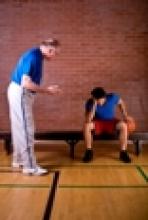
Federal law defines child abuse and neglect as, at minimum, any recent act or failure to act on the part of a parent or caretaker which results in death, serious physical or emotional harm, sexual abuse or exploitation to a child, or an act or failure to act which presents an imminent risk of serious harm.
In the context of youth sports, child abuse can take many, and perhaps, to some, surprising forms:
Emotional abuse
Is a verbal attack on a child's self esteem by a person in a position of power, authority, or trust such as a parent or coach, and occurs even if the attack is intended as a form of discipline or is not intended by the adult to cause harm
Can take many forms, including any of the following:
- Name calling ("Hey, Fatty!" or "Hey, Shorty" or "Hey, Mr. Klutz")
- Threatening ("If you don't win, you can forget about me buying that new CD you want")
- Insulting ("You're stupid" or "You're clumsy" or "You're an embarrassment to our family" or "You don't deserve to wear that uniform.")
- Bullying or taunting by a teammate.
- Criticizing or ridiculing ("You are a loser" or "I thought you were better than that. I guess I was wrong.")
- Intimidating ("Watch out kid, my son is going to break your nose")
- Yelling at a child for losing or not playing up to the adult's expectations
- Hazing
- Negative questioning ("Why didn't you win?" or "How could you let that guy beat you?")
- Shunning or withholding love or affection (not speaking to, hugging, or comforting your child after she plays poorly in a game or practice, or her team loses; showing obvious signs of disappointment)
- Punishing a child for not playing up to your expectations or when her team loses.
Physical Abuse
Occurs when a person in a position of power, authority or trust such as a parent or coach purposefully injures or threatens to injure a child
Can take many forms, including any of the following:
- Slapping
- Hitting
- Shaking
- Throwing equipment
- Kicking
- Pulling hair
- Pulling ears
- Striking
- Shoving
- Grabbing
- Hazing
- Punishing "poor" play or rules violations through the use of excessive exercise (extra laps etc.)1 or by denying fluids.
Sexual Abuse
Occurs when a person in a position of power, authority or trust engages in sex with a child or "sexualized" touching, which is where touching, instead of being respectful and nurturing, is done in a sexual manner, such as fondling instead of a hug; a long kiss on the lips instead of a peck on the cheek, or seductive stroking of any area of the child's body instead of a simple pat on the rear-end for a good play.
What Is Harassment?
Your child is being harassed when she or he is threatened, intimidated, taunted, or subjected to racial, homophobic, or sexist slurs. Sexual harassment includes comments, contact or behavior of a sexual nature that is offensive, uninvited or unwelcome. For more articles on sexual abuse in sports, click here.
Neglect
Neglect is a chronic inattention to the basic necessities of life such as supervision, medical and dental care, adequate rest, safe environment, exercise, and fresh air.
Neglect in a sports setting may take the following forms:
- Injuries are not properly treated
- Athletes are forced to play hurt
- Equipment is inadequate, poorly maintained or unsafe
- Road trips are not properly supervised
- Allowing bullying by teammates.



